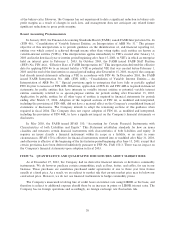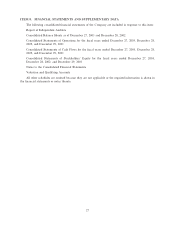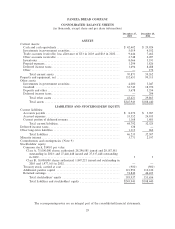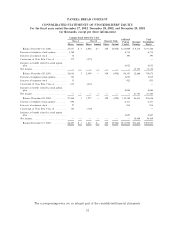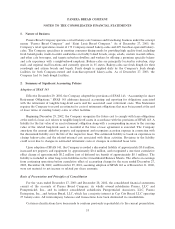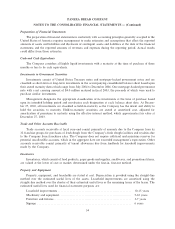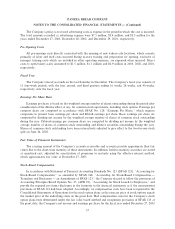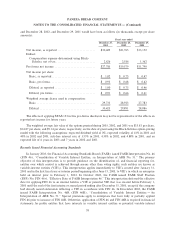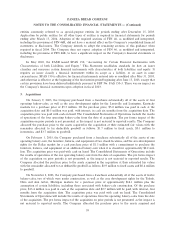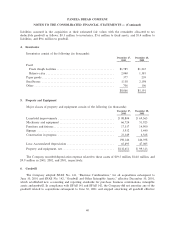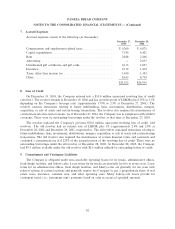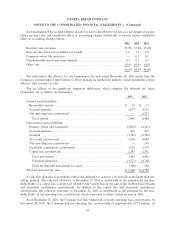Panera Bread 2003 Annual Report Download - page 39
Download and view the complete annual report
Please find page 39 of the 2003 Panera Bread annual report below. You can navigate through the pages in the report by either clicking on the pages listed below, or by using the keyword search tool below to find specific information within the annual report.PANERA BREAD COMPANY
NOTES TO THE CONSOLIDATED FINANCIAL STATEMENTS Ì (Continued)
Interest, to the extent it is incurred, is capitalized when incurred in connection with the construction of
new locations or facilities. The capitalized interest is recorded as part of the asset to which it relates and is
amortized over the asset's estimated useful life. No interest was incurred for such purposes in 2003, 2002, or
2001.
Upon retirement or sale, the cost of assets disposed of and their related accumulated depreciation are
removed from the accounts. Any resulting gain or loss is credited or charged to operations. Maintenance and
repairs are charged to expense when incurred, while betterments are capitalized.
Goodwill
Intangible assets consist of goodwill arising from the excess of cost over the fair value of net assets
acquired from the acquisitions of the Saint Louis Bread Company, franchisee bakery-cafes, and a franchisee
fresh dough facility.
The Company adopted Statement of Financial Accounting Standards No. 141 (""SFAS 141''), ""Business
Combinations'' for all acquisitions subsequent to June 30, 2001 and ""SFAS No. 142, ""Goodwill and Other
Intangible Assets,'' eÅective December 30, 2001, which established new accounting and reporting standards
for purchase business combinations, intangible assets and goodwill. In compliance with SFAS 141 and
SFAS 142, the Company did not amortize any of the goodwill related to acquisitions subsequent to June 30,
2001 and stopped amortizing all goodwill eÅective December 30, 2001. SFAS 142 requires goodwill and
indeÑnite-lived intangible assets recorded in the Ñnancial statements to be evaluated for impairment annually
or when events or circumstances occur indicating that goodwill might be impaired. The Company performs its
impairment assessment by comparing discounted cash Öows from acquired businesses with the carrying value
of the underlying net assets inclusive of goodwill. The Company completed the transitional impairment test as
of December 30, 2001, and our annual impairment tests as of the Ñrst day of the fourth quarter of 2002 and
2003, none of which identiÑed any impairment. Amortization expense was $1.0 million for the year ended
December 29, 2001.
Impairment of Long-Lived Assets
EÅective December 30, 2001, the Company adopted SFAS 144, ""Accounting for the Impairment of
Long-Lived Assets.'' In accordance with SFAS 144, the Company evaluates whether events and circum-
stances have occurred that indicate the remaining estimated useful life of long lived assets may warrant
revision or that the remaining balance of an asset may not be recoverable. The Company determines if there is
an impairment by comparing undiscounted cash Öows from the related long-lived assets of a bakery-cafe or
fresh dough facility with their respective carrying values. The amount of an impairment is determined by
comparing anticipated discounted future operating cash Öows from the related long-lived assets of a bakery-
cafe or a fresh dough facility with their respective carrying values. In performing this analysis, management
considers such factors as current results, trends, future prospects and other economic factors. No impairment
of long-lived assets was determined at December 27, 2003 and December 28, 2002.
Self-Insurance Reserves
The Company is self-insured for a signiÑcant portion of its workers' compensation and general, auto, and
property liability insurance. Liabilities associated with the risks that are retained by the Company are
estimated, in part, by considering historical claims experience of the Company and the industry and other
actuarial assumptions. The estimated accruals for these liabilities could be aÅected if future occurrences and
claims diÅer from these assumptions and historical trends. As of December 27, 2003 and December 28, 2002,
these reserves were $2.1 million and $1.4 million, respectively, and were included in accrued expenses in the
consolidated balance sheets.
35



